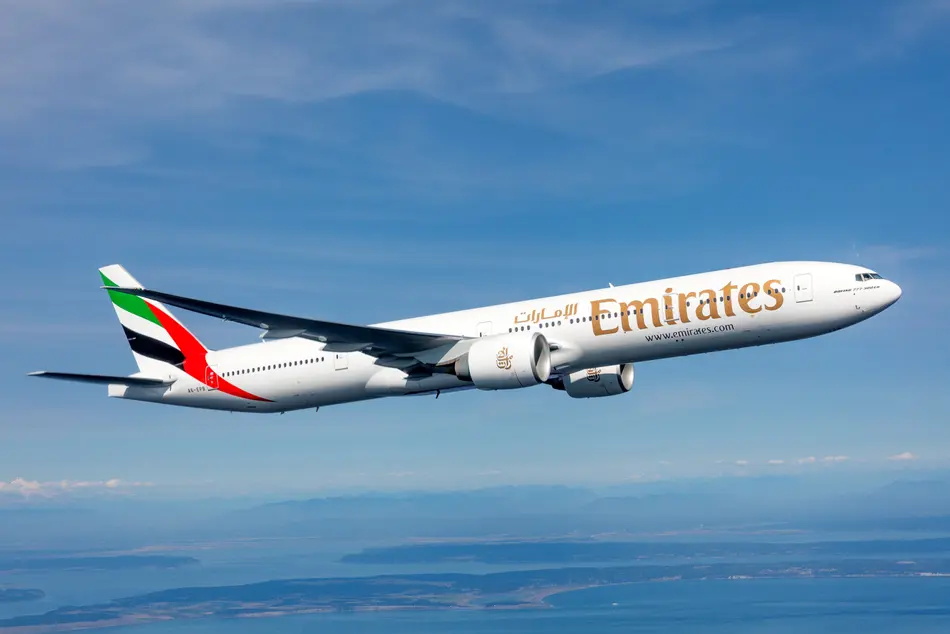Pressure Mounts For 777-9 And A350-1000 Stretches
As the hub of Emirates’ Airline’s operations, Dubai International Airport averages at least 80 Airbus A380 movements per day, making it the undisputed center of the world’s very large jet market.

As the hub of Emirates’ Airline’s operations, Dubai International Airport averages at least 80 Airbus A380 movements per day, making it the undisputed center of the world’s very large jet market.
But as passenger numbers through the Persian Gulf continue to grow, operators like Emirates—and others serving the region with A380s—face a dilemma. From the mid-2030s onward, the era of the double-decker Airbus will be coming to an end, and there is nothing on the drawing board to replace it that is remotely close in capacity.
While there seems to be no prospect of another all-new 500-plus seater for the foreseeable future, Emirates is looking at the next-best idea: a simple stretch of the world’s largest new twinjets, the Airbus A350-1000 and the in-development Boeing 777-9. Leading the charge, Emirates Airline President Tim Clark is pushing the two OEMs to begin studies of the growth variants, reminding them that in the world of widebody development schedules, the next decade is practically tomorrow.
Clark believes a stretched version of the 777-9—unofficially but unsurprisingly dubbed the -10—would only be available at the earliest well into the 2030s. A larger variant of the A350-1000, already in service and production, could debut sooner.
Emirates placed a follow-up order for 65 777-9s on Nov. 17, a deal that included the option to convert to a larger version of the 777X, should Boeing launch one. “We want them to take a good, hard look at a stretch,” Clark told reporters at the Dubai Airshow the next day. At the same time, “Boeing has their hands full, and we all know that,” he added. Clark pointed to the precedent of previous aircraft iterations in which there were gaps of 5-6 years between the different versions “even in normal conditions.”
For Emirates, worsening hub congestion will add to the pressure to keep seat count high. Still, the planned move to the new Dubai World Central Airport, which is readying its next expansion for 2032, will make it easier for the carrier to increase frequencies than at the very constrained Dubai International Airport.
Clark believes the 777-10 is technically feasible. “A maximum takeoff weight increase is coming, anyway—the wing will be standard for the -9 and everything else,” he tells Aviation Week. “The GE engine has growth in it as well,” he notes, referring to the 777-9’s GE Aerospace GE9X turbofan.
While the larger 777 would serve a niche market, Clark is convinced that if Boeing launches the 777-10, Emirates will not be the only customer. He told the manufacturer: “If you do this, we will not be alone.”
Emirates also wants Airbus to launch an A350-2000. “My phone is full of messages between me and [Airbus Commercial CEO] Christian Scherer,” Clark said. However, he thinks it will be harder for Airbus to build a larger version of the aircraft than for Boeing to stretch the 777, partly because it would have to be “a new engine for the -2000.”
Clark says the Rolls-Royce Trent XWB-97 that powers the A350-1000 “does not have the capabilities under our conditions.” But he adds that while Airbus and the UK engine-maker face a conundrum, “it is all fixable.”
Scherer says that not only is the Trent XWB capable of powering a larger A350, but the airframer could build a stretched version of the big twin. Beyond Emirates, Scherer says Airbus is seeing increasing customer demand for such an aircraft.
“We are not prepared to launch the stretch yet,” Scherer tells Aviation Week. “We have more homework to do.” But several customers are “saying we want competition in the large capacity market,” he notes. “And the A350 is an airplane that has the capability of being stretched. People pretty much everywhere are talking to us [about it]. In the current market circumstances, there is a longing for larger aircraft.”
Airbus is looking at adding another four rows or 40 seats. “It is still flexible; it will be around that,” Scherer says. “We have an engine that is certified and flies and an aircraft that flies and is certified. That is more than can be said about the 777X.
“The XWB-97 is an engine that is limited to 97,000 lb. of thrust,” he continues. “But it does not prevent the -1000 from being the longest-range aircraft in the world today.” Scherer points to the upcoming upgrades of the engine that will bring it to “durability levels experienced by traditional engines in this region.”
“Airbus has only had very tentative conversations about a stretch of the A350,” Simon Burr, group director of engineering, technology and safety at Rolls-Royce, told Aviation Week at the Paris Air Show in June. “If they want to do a simple stretch and put something into service quite quickly, that drives you down one route.” He suggested upgrades of the higher-thrust XWB-97 variant are more likely than seeing the extended derivative as a potential launch application of the company’s geared UltraFan powerplant.
“If you put an UltraFan on an existing aircraft, you’ve got to change the wing, because the weight is in a different place, the engine is heavier, and the weight is further forward,” Burr said. “So to optimize integration, it’s a very significant investment. It really depends on how you want to access that market—whether it’s a quick entry or it’s a longer-term play.”
For the stretch, Airbus would necessarily trade capacity for range. “If you stretch the engine and you are limited in thrust, then by definition you are going to lose some range,” Scherer says. “Is that a big deal? Not for the people we are talking to. We don’t need to fly from Auckland to London everyday.”
Scherer does not say when Airbus might launch the aircraft. “We need to phase it in, in terms of deployment of engineering resources,” he explains. “We have the [A350] ULR to finish, we have the freighter, the A220 stretch to do. But we can do it. We are not fundamentally resource-constrained.”
Boeing, meanwhile, says a technical feasibility study of a stretched 777-10 derivative will be driven largely by takeoff performance requirements. In the case of such a large-capacity, twin-engine aircraft, these requirements focus mainly on meeting current critical engine failure certification rules.
Although details of potential configuration changes have yet to be evaluated, “we’ve committed to a study with Emirates to understand those things,” says Justin Hale, customer leader for the 777X.
Boeing’s feasibility study will cover proposed -10 configurations ranging from a relatively modest stretch—like that of the 777-300ER to the -9—to more significant extensions, like the original leap from the baseline 777-200 to the 777-300/300ER. The original 777-300ER was stretched to 242 ft. in length, or around 4 ft. longer than an A380, with the addition of a nine-frame (189-in.) aft fuselage extension and a 10-frame (210-in.) forward fuselage plug. For the 777-9, the fuselage was extended another 9 ft. and the wingspan to 212 ft. with the addition of 6.5-ft. tip extensions.
To increase maximum seating capacity to 470, or the 50-plus additional passengers targeted by Emirates, the 251-ft.-9-in.-long 777-9 would notionally be accommodated with a stretch of around 16 ft. This would take the -10’s overall length to about 268 ft. While the 777X’s electronic tailskid protection system would protect the aircraft from overrotation with the existing main landing gear, Hale explains that “it’s more about the impact on takeoff performance.”
The -10 evaluation will also cover design aspects ranging from added structural weight to payload range changes. “Those are all the things that a study would have to go look at,” Hale adds.
Takeoff performance for any aircraft, but particularly for one with two engines, must consider the effect of an engine failure and changes to takeoff distance and climb rate. Designers must also factor in the effect on controllability, as the aircraft must maintain directional control after an engine failure.
Although the possible size of a prospective 777-10 and its market potential remain unknown, Boeing continues to “investigate what other things are in the art of the possible,” says Darren Hulst, vice president of commercial marketing. “We don’t stop once we deliver [a product]. We’re thinking about what other innovations we can bring, whether it’s more range, more payload, more capacity. Those are the things that we’re looking at in the near term to see where the market is.”
Hulst says the 777-10 feasibility study will include a trade-off between risk and versatility or flexibility. The future replacement market for airliners with more than 350 seats, including the current fleets of A380s and 777-300ERs, is just over 1,000. “The vast majority of those airplanes probably want to be replaced by the 777-9 because it’s the right size aircraft that provides growth, but maybe not significantly more growth and risk than what the market wants,” Hulst says.
“Sometimes the trade-off on risk is too expensive,” he continues. “I think as we look forward, the question is going to be: What is the trade-off between risk or more capacity versus a platform for more capacity?”



